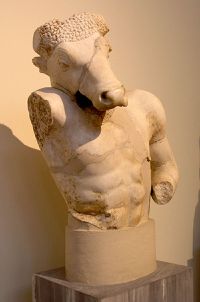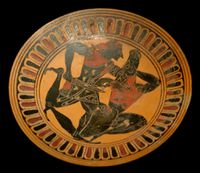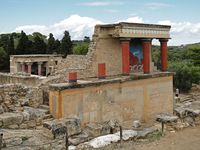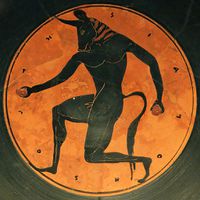Difference between revisions of "What was the legend of the Minotaur"
m (Admin moved page What was the legend of the Minotaur? to What was the legend of the Minotaur) |
|||
| (One intermediate revision by the same user not shown) | |||
| Line 1: | Line 1: | ||
| − | + | [[File: Minotaur One.jpg|200px|thumbnail|left| Bust of Minotaur]]__NOTOC__ | |
| − | [[File: Minotaur One.jpg|200px| | ||
The legend of the Minotaur is one of the most enigmatic in all of World mythology, but it has also been very influential. The story of the half-man and half-bull in the labyrinth in Crete has fascinated people for thousands of years and is one of the best-known myths from the Classical World. It appears that this myth was most likely based on historical precedents. | The legend of the Minotaur is one of the most enigmatic in all of World mythology, but it has also been very influential. The story of the half-man and half-bull in the labyrinth in Crete has fascinated people for thousands of years and is one of the best-known myths from the Classical World. It appears that this myth was most likely based on historical precedents. | ||
| Line 19: | Line 18: | ||
====Theseus and the Minotaur==== | ====Theseus and the Minotaur==== | ||
| − | [[File: Minotaur Four.jpg|200px| | + | [[File: Minotaur Four.jpg|200px|thumbnail|left|Restored Minoan Palace]] |
The son of King Aegeus, Theseus, volunteered to be sent to Crete. He believed that he had the strength and power to kill the fearsome half-bull and half-man. After some time, Theseus finally persuaded the king to send him to Crete. Minos received the young Athenian and, on account of his royal birth, treated him with respect. Theseus told the Cretan king that he would kill the creature. However, the monarch was not afraid, he knew that the Athenians could not escape the maze that was escape-proof. However, Minos was unaware that his daughter Adriane had fallen in love with Theseus and agreed to help him in his quest. She gave him a ball of string or thread before he went into the labyrinth. The Athenians then went into the maze and used the string, which was still being held by Ariadne to mark the way back to the entrance of the labyrinth.<ref>Morford, Mark PO, and Robert J. Lenardon. Classical mythology (Oxford, Oxford University Press, USA, 1999), p 113</ref> | The son of King Aegeus, Theseus, volunteered to be sent to Crete. He believed that he had the strength and power to kill the fearsome half-bull and half-man. After some time, Theseus finally persuaded the king to send him to Crete. Minos received the young Athenian and, on account of his royal birth, treated him with respect. Theseus told the Cretan king that he would kill the creature. However, the monarch was not afraid, he knew that the Athenians could not escape the maze that was escape-proof. However, Minos was unaware that his daughter Adriane had fallen in love with Theseus and agreed to help him in his quest. She gave him a ball of string or thread before he went into the labyrinth. The Athenians then went into the maze and used the string, which was still being held by Ariadne to mark the way back to the entrance of the labyrinth.<ref>Morford, Mark PO, and Robert J. Lenardon. Classical mythology (Oxford, Oxford University Press, USA, 1999), p 113</ref> | ||
| Line 30: | Line 29: | ||
====The historicity of the Minotaur==== | ====The historicity of the Minotaur==== | ||
| − | [[File: Minotaur Three.jpg|200px| | + | [[File: Minotaur Three.jpg|200px|thumbnail|left| Minotaur on Athenian dish]] |
There is a great deal of evidence that suggests that there is some basis for the myth in real life. The name Minos was found on a clay tablet. It does not refer to a king but was the title of the consort of the queen. The myth of the maze that was the home and the prison of the half-man and half-bull may have some basis also in fact. So far, archaeologists have not found any evidence of a maze. Some have suggested that the sprawling palace complexes of the Minoans inspired the legend of the maze. However, archaeologists have found evidence of a dancing floor. Homer mentions this in his epic poem, the Iliad. It appears that young people may have performed intricate dances on this floor that were of religious significance. It appears that the dancing floor was an intricate mosaic, and it morphed into a maze in the imagination of storytellers and poets. The frescoes that have been uncovered at the Minoan palaces have helped clarify the myth's roots. Paintings and figurines, dating from 1700 to 1400 B.C., show young men vaulting over bulls. This is a ritual that was named Tauro-kathapsia. | There is a great deal of evidence that suggests that there is some basis for the myth in real life. The name Minos was found on a clay tablet. It does not refer to a king but was the title of the consort of the queen. The myth of the maze that was the home and the prison of the half-man and half-bull may have some basis also in fact. So far, archaeologists have not found any evidence of a maze. Some have suggested that the sprawling palace complexes of the Minoans inspired the legend of the maze. However, archaeologists have found evidence of a dancing floor. Homer mentions this in his epic poem, the Iliad. It appears that young people may have performed intricate dances on this floor that were of religious significance. It appears that the dancing floor was an intricate mosaic, and it morphed into a maze in the imagination of storytellers and poets. The frescoes that have been uncovered at the Minoan palaces have helped clarify the myth's roots. Paintings and figurines, dating from 1700 to 1400 B.C., show young men vaulting over bulls. This is a ritual that was named Tauro-kathapsia. | ||
| Line 44: | Line 43: | ||
====Conclusion==== | ====Conclusion==== | ||
This tale has influenced western culture for centuries and has given us the concept of the labyrinth. The myth of the Minotaur almost certainly is based on events and practices from the Minoan civilization. The half-man and the half-bull story is probably a Greek interpretation of a historical culture that they imperfectly understood. This story taught people to fear the Gods, like so many other fables. It can be regarded as one of the many myths told around the world that told of humans and animals' hybrids. The story of Theseus and the Minotaur inspired many artists and was adopted by the Romans, including the Etruscans. This tale allows us to understand something of the history of the Minoans and also the mindset of the Greeks and their values. The life and death of the Minotaur was also a political fable. | This tale has influenced western culture for centuries and has given us the concept of the labyrinth. The myth of the Minotaur almost certainly is based on events and practices from the Minoan civilization. The half-man and the half-bull story is probably a Greek interpretation of a historical culture that they imperfectly understood. This story taught people to fear the Gods, like so many other fables. It can be regarded as one of the many myths told around the world that told of humans and animals' hybrids. The story of Theseus and the Minotaur inspired many artists and was adopted by the Romans, including the Etruscans. This tale allows us to understand something of the history of the Minoans and also the mindset of the Greeks and their values. The life and death of the Minotaur was also a political fable. | ||
| + | |||
| + | <youtube>https://www.youtube.com/watch?v=2aoIs-5zqoI</youtube> | ||
====Further Reading==== | ====Further Reading==== | ||
Latest revision as of 01:20, 22 September 2021
The legend of the Minotaur is one of the most enigmatic in all of World mythology, but it has also been very influential. The story of the half-man and half-bull in the labyrinth in Crete has fascinated people for thousands of years and is one of the best-known myths from the Classical World. It appears that this myth was most likely based on historical precedents.
The myth of the Minotaur will be examined and summarized. Then there is a discussion of the meaning and the significance of the fable. The story of the half-man and half-bull is full of symbolic meaning and allows us to understand the mindset of an a-long bygone age.
The story of the Minotaur
The myth is set on the island of Crete, which in the Early History of Greece was very important. There are no direct references to the mythic creature in the works of Homer, but the monster is referred to in a fragment of a poem written by the poetess Sappho of Lesbos. The tale of the Minotaur begins with King Minos, the Cretan King, who was the son of the King of the Gods Zeus and Europa. When his stepfather died, he made himself King of Crete and its many dependent islands. His brother Sarapedon questioned the right of Minos to become King.[1] He stated that it was the will of the Gods.
Minos proved that he was the rightful King when Poseidon (the sea-god), sent him a white bull, from the sea, as a sign of his legitimacy. Now Minos was meant to sacrifice this beautiful white bull to show his gratitude to the sea-god, but he let it live because of its rarity and sacrificed a different and less valuable bull. The new King married the goddess Pasiphae, and they had several children, and Crete prospered and grew stronger. Poseidon learned about the white bull, and he was enraged, and in revenge he caused the wife of Minos to fall in love with the beast.[2]
In the Roman version of the myth, Venus made the Cretan Queen fall in love with the white bull. Pasiphae was fascinated with the animal, and she had the legendary craftsman Daedalus built her a wooden cow. When the queen of Minos was in the decoy cow, she was able to trick the bull into mating with her.
The offspring of this was Minotaur, who is described in the ancient texts, as a massive creature, with a strong human body and the head of a bull, complete with horns. His mother christened the child Asterion, but he became known as the Minotaur, which means ‘bull of Minos.’ Naturally, when the Cretan heard about this he was angered and decided to hide the half-bull and half-human child.[3] He enslaved Daedalus and ordered him to build a labyrinth or a maze to hold the animal. This is the first known reference to a labyrinthine structure. The hybrid could not escape from the maze, and no one could ever leave who entered it.
The maze was designed to be escape-proof, and those who entered it were doomed to wander it, endlessly until they died. It appears that the Minotaur would eat any human who came to the maze, and many unfortunates died in his labyrinth. In the myth, the Cretan King’s eldest son was killed by the bull that impregnated his mother at the Panathenaic Games. The monarch blamed the Athenians for this tragedy.
Minos demanded that every nine years that the Athenian King Aegeus send him seven young women and seven young males, if not, the city would be ravaged by a plague. [4] Aegeus was forced to agree, and the young Athenians who were sent to Crete from Athens were sacrificed to the bloodthirsty Minotaur in his maze.
Theseus and the Minotaur
The son of King Aegeus, Theseus, volunteered to be sent to Crete. He believed that he had the strength and power to kill the fearsome half-bull and half-man. After some time, Theseus finally persuaded the king to send him to Crete. Minos received the young Athenian and, on account of his royal birth, treated him with respect. Theseus told the Cretan king that he would kill the creature. However, the monarch was not afraid, he knew that the Athenians could not escape the maze that was escape-proof. However, Minos was unaware that his daughter Adriane had fallen in love with Theseus and agreed to help him in his quest. She gave him a ball of string or thread before he went into the labyrinth. The Athenians then went into the maze and used the string, which was still being held by Ariadne to mark the way back to the entrance of the labyrinth.[5]
In the dark heart of the maze, Theseus encountered the enraged Minotaur and the two began a life and death struggle. The Athenian managed to kill the half-man half-bull. There are two versions as to how he did it, in one he killed the Minotaur with his bare hands and in another he killed him with a blade that Ariadne gave him. Later Theseus escaped from Crete with Ariadne, but he soon abandoned her on the island of Naxos. There are many depictions in Roman and Greek art of Theseus killing the Minotaur.[6]
The Minotaur and Minoan civilization
The myth of the Minotaur is deeply associated with the island of Crete. It is now widely accepted that the legend is based on the Minoan Bronze Age civilization that flourished on the island in the Bronze Age, from about 2700 to c. 1450 BC.[7] The civilization is named after Minos, and we do not know what its people called themselves, as no-one has been able to decipher their writings. Many regard the Minoans as the first European civilization. Despite this, they were forgotten about for millennia. This culture was only uncovered in the 19th century by one of the pioneers of archaeology Sir Arthur Evans.
Archaeologists have revealed a large number of palaces. The most famous of these is the palace at Knossos. These also contain remarkable frescoes, some of the first masterpieces of European art. It appears that the Minoans established a maritime empire in the Aegean. They were also great traders and traded with the city-states and Empires in the Levant. By around 1500 BC, civilization began to decline. Various explanations for this have been offered, including volcanic eruption and an invasion of Dorian Greeks from mainland Greece.[8]
The historicity of the Minotaur
There is a great deal of evidence that suggests that there is some basis for the myth in real life. The name Minos was found on a clay tablet. It does not refer to a king but was the title of the consort of the queen. The myth of the maze that was the home and the prison of the half-man and half-bull may have some basis also in fact. So far, archaeologists have not found any evidence of a maze. Some have suggested that the sprawling palace complexes of the Minoans inspired the legend of the maze. However, archaeologists have found evidence of a dancing floor. Homer mentions this in his epic poem, the Iliad. It appears that young people may have performed intricate dances on this floor that were of religious significance. It appears that the dancing floor was an intricate mosaic, and it morphed into a maze in the imagination of storytellers and poets. The frescoes that have been uncovered at the Minoan palaces have helped clarify the myth's roots. Paintings and figurines, dating from 1700 to 1400 B.C., show young men vaulting over bulls. This is a ritual that was named Tauro-kathapsia.
Some have suggested that the youths jumping the bulls was part of a religious rite, and if they died during it, they were in effect sacrifices to the gods. It appears that bulls were sacrificed to unknown gods by the prehistoric Cretans. The Minotaur may also have been based on a Cretan fertility cult as the bull is a near-universal symbol of fecundity. The hybrid figure may even represent some priest or deity. What is clear is that bulls were an important part of Minoan religion and society. Another possible suggestion for the origin of the myth is the unpredictable geology of Crete. This island is very prone to earthquakes, and there have been suggestions that the image of the bull, trapped underground in a maze, was the personification of earthquakes. The story of the subterranean monster was an explanation by a pre-scientific society for earthquakes on the island.
The meaning of the Minotaur
Today, no one takes myth literally, and it is acknowledged to be an interpretation or even misunderstandings of historical events or personages. However, they did impart essential values, ideas and provided explanations for our forebears. The killing of the Minotaur by Theseus may represent an old religion's replacement by a new one. This myth may tell the story of the ancient Minoan religion represented by the hybrid being supplanted by the Greeks' new religion, symbolized by Theseus. It is known that the Minoan culture was very influential in mainland Greece until the Late Mycenaean Age.
The story of the Athenian slaying, the white bull's son, may represent the end of the Minoan religion's influence on mainland Greece during the Bronze Age. Like many myths, there was a moral imperative implicit in the myth. They often relate what happens if the social norms are ignored and what happens when humans transgress and break the laws of nature and the gods. The story of the Minotaur shows what happens when humans disrespect the gods, as Minos had. Another important theme in ancient fables was the triumph of civilization over nature. Theseus killing of the monster was often regarded as the victory of human society and humanity over animals and nature's forces.
Mythic tales are often surprisingly political, which is also the case with the monster's narrative in the labyrinth. Some believe that Theseus' victory over the bull-man represents the end of mainland Greece's Minoan domination, possibly during the Mycenaean era. It also appears that the myth of the Minotaur became very popular with the Athenians and others during the Persian Invasions. It appears that the fabulous narrative was adopted by many to symbolize the threat posed by the Persians, represented by the Minotaur. While Theseus was Greece's personification and his defeat of the monster, it represented the Hellenes' victory over the Persians.
Conclusion
This tale has influenced western culture for centuries and has given us the concept of the labyrinth. The myth of the Minotaur almost certainly is based on events and practices from the Minoan civilization. The half-man and the half-bull story is probably a Greek interpretation of a historical culture that they imperfectly understood. This story taught people to fear the Gods, like so many other fables. It can be regarded as one of the many myths told around the world that told of humans and animals' hybrids. The story of Theseus and the Minotaur inspired many artists and was adopted by the Romans, including the Etruscans. This tale allows us to understand something of the history of the Minoans and also the mindset of the Greeks and their values. The life and death of the Minotaur was also a political fable.
Further Reading
Hard, Robin. The Routledge Handbook of Greek mythology (London, Routledge, 2019).
Callender, Gae The Minoans, and the Mycenaeans: Aegean Society in the Bronze Age. (Australia Oxford University Press 1999)
Apollodorus. The Library of Apollodorus. Translated by Simpson, Michael (Amherst: University of Massachusetts Press, 1978).
References
- ↑ Grant, Michael, and John Hazel. Who's who in Classical Mythology (London, Routledge, 2004), p. 45
- ↑ Calimachus, Hymn 4
- ↑ Grant and John, p. 115
- ↑ Buxton, Richard, and Richard GA Buxton. Imaginary Greece: The contexts of mythology (Cambridge, Cambridge University Press, 1994), p 113
- ↑ Morford, Mark PO, and Robert J. Lenardon. Classical mythology (Oxford, Oxford University Press, USA, 1999), p 113
- ↑ Bosworth, J. Oxford Dictionary of the Classical World (Oxford, Oxford University Press, 2003), p 167
- ↑ Bosworth, p. 178
- ↑ Bosworth, p. 201



